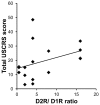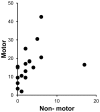Dopamine receptor autoantibodies correlate with symptoms in Sydenham's chorea
- PMID: 24073196
- PMCID: PMC3779221
- DOI: 10.1371/journal.pone.0073516
Dopamine receptor autoantibodies correlate with symptoms in Sydenham's chorea
Abstract
Background: Sydenham chorea (SC), a neuropsychiatric sequela of group-A streptococcal infection, is associated with basal ganglia autoantibodies. Although autoantibodies have been proposed in neuropsychiatric disorders, little evidence has been shown to link autoimmunity and clinical symptoms. We hypothesized that dopamine receptor-autoantibody interactions may be the basis of neuropsychiatric symptoms in SC.
Methods: Sera from 22 children with SC (age 10.7±4.5 years) and 22 age-matched controls were studied. Clinical neuropsychiatric symptoms were measured in SC at sample collection using the UFMG-Sydenham's-Chorea-Rating-Scale (USCRS). Anti-dopamine D1 receptor (D1R) and anti-dopamine D2 receptor (D2R) autoantibodies were measured by the enzyme linked immunosorbent assay (ELISA) and were correlated with clinical symptoms.
Results: Anti-D1R and anti-D2R autoantibodies were significantly higher in SC compared to controls (n = 44; p = 0.010 and p = 0.017, respectively). We found that the ratio (anti-D2R/D1R) of the two anti-dopaminergic receptor antibodies correlated with neuropsychiatric symptoms as determined by USCRS measurements (n = 18; r = 0.53, p = 0.024). In addition, anti-D2R titers correlated with antistreptolysin-O titers (n = 43; r = 0.49, p = 0.0008).
Interpretation: Our report linked, for the first time, autoimmunity with neuropsychiatric symptoms. The significant correlation was found using ratios of autoantibodies against dopamine receptors (anti-D2R/D1R) rather than the absolute elevated individual anti-D1R or anti-D2R titers. We suggest that autoantibodies may lead to a receptor imbalance and induce greater sensitivity to dopamine signaling potentially leading to neuropsychiatric symptoms in SC. Our novel findings suggesting altered balance in the dopaminergic system may provide a new approach in understanding autoimmune neuropsychiatric disorders with possible implications for diagnosis and treatment.
Conflict of interest statement
Figures



References
-
- Cardoso F, Vargas AP, Oliveira LD, Guerra AA, Amaral SV (1999) Persistent Sydenham's chorea. Mov Disord 14: 805–807. - PubMed
-
- Church AJ, Cardoso F, Dale RC, Lees AJ, Thompson EJ, et al. (2002) Anti-basal ganglia antibodies in acute and persistent Sydenham's chorea. Neurology 59: 227–231. - PubMed
-
- Garvey MA, Snider LA, Leitman SF, Werden R, Swedo SE (2005) Treatment of Sydenham's chorea with intravenous immunoglobulin, plasma exchange, or prednisone. J Child Neurol 20: 424–429. - PubMed
-
- Kirvan CA, Swedo SE, Heuser JS, Cunningham MW (2003) Mimicry and autoantibody-mediated neuronal cell signaling in Sydenham chorea. Nat Med 9: 914–920. - PubMed
Publication types
MeSH terms
Substances
Grants and funding
LinkOut - more resources
Full Text Sources
Other Literature Sources
Medical

